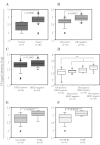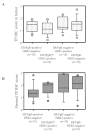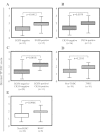High expression of thymidine phosphorylase in basal-like breast cancers: Stromal expression in EGFR- and/or CK5/6-positive breast cancers
- PMID: 22966291
- PMCID: PMC3436479
- DOI: 10.3892/ol_00000046
High expression of thymidine phosphorylase in basal-like breast cancers: Stromal expression in EGFR- and/or CK5/6-positive breast cancers
Abstract
Expression of the estrogen receptor (ER), the progesterone receptor (PgR) or the human epidermal growth factor receptor-2 (HER2) in tumors is a good prognostic marker for breast cancer patients. However, approximately 15-20% of breast cancer patients have triple-negative breast cancer (TNBC; negative for ER, PgR and HER2), and efficient therapeutic modalities for these patients are under investigation. We focused on thymidine phosphorylase (TP), an enzyme metabolizing 5'-DFUR, an intermediate of capecitabine, to 5-fluorouracil in order to investigate the application of well-known therapeutics for TNBC. Results of a gene expression analysis showed that TP expression in TNBC and basal-like breast cancer (BLBC) was higher than that of other subtypes. Immunohistochemically, the high expression of TP in TNBC and BLBC reflected expression in stromal but not tumor cells. Notably, a high TP expression was observed in the stromal cells of EGFR- and/or CK5/6-positive breast tumors. Our present results showing a high expression of TP in BLBC indicate that capecitabine-based chemotherapy would be of benefit for patients with TNBC.
Figures





Similar articles
-
Immunohistochemical co-expression status of cytokeratin 5/6, androgen receptor, and p53 as prognostic factors of adjuvant chemotherapy for triple negative breast cancer.Med Mol Morphol. 2016 Mar;49(1):11-21. doi: 10.1007/s00795-015-0109-0. Epub 2015 May 26. Med Mol Morphol. 2016. PMID: 26009308
-
Differential response of immunohistochemically defined breast cancer subtypes to anthracycline-based adjuvant chemotherapy with or without paclitaxel.PLoS One. 2012;7(6):e37946. doi: 10.1371/journal.pone.0037946. Epub 2012 Jun 5. PLoS One. 2012. PMID: 22679488 Free PMC article.
-
c-Met and ERβ expression differences in basal-like and non-basal-like triple-negative breast cancer.Tumour Biol. 2016 Aug;37(8):11385-95. doi: 10.1007/s13277-016-5010-5. Epub 2016 Mar 11. Tumour Biol. 2016. PMID: 26968553
-
Triple-negative breast cancer: disease entity or title of convenience?Nat Rev Clin Oncol. 2010 Dec;7(12):683-92. doi: 10.1038/nrclinonc.2010.154. Epub 2010 Sep 28. Nat Rev Clin Oncol. 2010. PMID: 20877296 Review.
-
Treatment of triple negative breast cancer (TNBC): current options and future perspectives.Cancer Treat Rev. 2010 Nov;36 Suppl 3:S80-6. doi: 10.1016/S0305-7372(10)70025-6. Cancer Treat Rev. 2010. PMID: 21129616 Review.
Cited by
-
The Ectopic Expression of SurvivinT34A and FilC Can Enhance the Oncolytic Effects of Vaccinia Virus in Murine Gastric Cancer.Onco Targets Ther. 2020 Feb 3;13:1011-1025. doi: 10.2147/OTT.S230902. eCollection 2020. Onco Targets Ther. 2020. PMID: 32099404 Free PMC article.
-
Evaluating the benefits and adverse effects of an enthracycline-taxane-capecitabine combined regimen in patients with early breast cancer.Oncotarget. 2017 Aug 22;8(46):81636-81648. doi: 10.18632/oncotarget.20386. eCollection 2017 Oct 6. Oncotarget. 2017. PMID: 29113420 Free PMC article. Review.
-
Pilot study investigating the prognostic significance of thymidine phosphorylase expression in patients with metastatic breast cancer: a single institution retrospective analysis.Onco Targets Ther. 2015 Apr 21;8:911-9. doi: 10.2147/OTT.S71089. eCollection 2015. Onco Targets Ther. 2015. PMID: 25960662 Free PMC article.
-
Anti-cancer drug sensitivity testing and preclinical evaluation of the anti-cancer potential of WEE1 inhibitor in triple-negative breast cancer patient-derived organoids and xenograft models.Breast Cancer Res. 2025 Jun 23;27(1):113. doi: 10.1186/s13058-025-02063-0. Breast Cancer Res. 2025. PMID: 40551232 Free PMC article.
References
-
- Early Breast Cancer Trialists Collaborative Group (EBCTCG) Effects of chemotherapy and hormonal therapy for early breast cancer on recurrence and 15-year survival: an overview of the randomised trials. Lancet. 2005;365:1687–1717. - PubMed
-
- Van’t Veer LJ, Dai H, van de Vijver MJ, et al. Gene expression profiling predicts clinical outcome of breast cancer. Nature. 2002;415:530–536. - PubMed
-
- Perou CM, Sørlie T, Eisen MB, et al. Molecular portraits of human breast tumours. Nature. 2000;406:747–752. - PubMed
LinkOut - more resources
Full Text Sources
Research Materials
Miscellaneous
